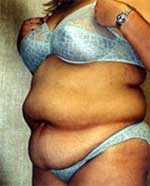|
Do you have a question for us? Please fill out the form and give us a chance to assist you
Go to Home Page
Locate Us |
||||||||
| Bariatric Surgery | ||||||||
Bariatrics concerns the causes, prevention and treatment of severe overweight, a condition known as obesity Bariatric operations are major gastrointestinal procedures which alter the capacity and/or the anatomy of the digestive system leading. Technique: The two types of bariatric surgeries are (1) restrictive - like Lap Band®, and (2)combined restrictive and malabsorptive - such as Roux-en-Y gastric bypass. The first type of surgical procedure simply reduces the size of the stomach, using staples and/or a band, resulting in a drastic reduction in the quantity of food it can ingest. The person feels fuller in a much lesser quantity of food then before the operation. The second reduces stomach capacity and bypasses the upper part of the small intestine, causing a reduction in the number of calories and nutrients which the body absorbs. Stomach bypass operations differ in both how the stomach is sectioned (stapling, banding or gastrectomy), and how much of the duodenum and jejunum are bypassed. General anaesthesia is recommended. Complements: Adopting a healthier lifestyle by eating a healthy diet and exercising which help having better results. This will completely depend on the patient's commitment to follow the guidelines outlined by their physician and dietary counselor. Results: Roux-en-Y gastric bypass procedure have a hospital stay of 2-4 days. Other gastric bypass procedures may have shorter or longer recovery times. Excess weight loss will begin immediately after gastric bypass surgery and typically continues for 18-24 months after surgery at which point many patients have lost between 50% and 100% of their excess weight. Patients must be more sensitive to their nutritional intake. With nutritional counseling and supplements, these effects can be lessened greatly. As the stomach is extremely sensitive for several weeks after gastric bypass surgery, initially patients subsist on a liquid or semi-liquid diet. Afterwards, solid food will make the patient feel full very quickly as the new stomach pouch usually only holds a tablespoon of food. Exercise in the form of walking should begin immediately following the hospital stay but more strenuous exercise should be gradually introduced 6-8 weeks after surgery. |
||||||||
|



